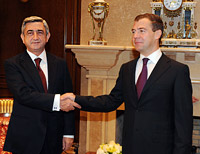Yesterday the famous American STRATFOR analytic center released a material, which relates to the continuing dispute between Armenia and Azerbaijan, internal divisions within Armenia and, of course, Russia, which has widespread influence throughout the region. Below is the translation of the article, which will interest many people especially if reviewed in the context of October 27, 1999.
Turkey and Armenia reached a symbolic deal Oct. 10 toward normalizing relations, but several important and interwoven hurdles still remain. These include a continuing dispute between Armenia and Azerbaijan, internal divisions within Armenia and, of course, Russia, which has widespread influence throughout the region. Armenian President Serzh Sargsyan met with Russian President Dmitri Medvedev Oct. 13 in Moscow and voiced his support for Russia’s contributions to Armenia’s diplomatic efforts in the Caucasus. The Moscow meeting came after Armenian Foreign Minister Edward Nalbandyan and his Turkish counterpart, Ahmet Davutoglu, held a highly anticipated meeting Oct. 10 in Zurich in which two protocols were signed — one on developing formal ties and the other on opening the border between the two countries. The protocols must now be sent to each country’s parliament for ratification. While the meeting between Armenia and Turkey was certainly significant, the agreements reached were primarily symbolic in nature; the two countries still face obstacles in completing the normalization process. Indeed, the protocol signing came after a meeting between Armenia and Azerbaijan collapsed just days earlier. According to STRATFOR sources in Armenia, Turkey was not pleased that these talks failed, with the main issue of the disputed enclave Nagorno-Karabakh left unsettled. Azerbaijan has warned that if Turkey agrees to a deal with Armenia without addressing the status of Nagorno-Karabakh, it would do its best to stymie or complicate Ankara’s normalization with Yerevan. STRATFOR sources say Turkey has now given Armenia an ultimatum: It will not follow through on the opening of the border between the two countries until this particular issue is solved — protocol or not. This is quite a threat by Turkey, and it shows that the protocols may be hollow and easily reversed. On the Armenian side, there is an enormous level of internal displeasure and dissent over the deal as well. Both the Armenian public and the government are still deeply divided over a rapprochement with the Turks, with the genocide issue still firmly in their collective minds. Within Armenia’s parliament, two opposition parties — Heritage and Armenian Revolutionary Federation — have already said they are against ratifying the protocols signed with Turkey. While these parties hold only 23 out of 121 seats in the National Assembly, STRATFOR is being told that the Republican Party — the ruling party of President Serzh Sargsyan that holds 64 seats — is split in half on this issue. Sargsyan himself is devoted to seeing the normalization process through, and because of the deep divide within his own party, this devotion could spell trouble for the leader. The next development to watch is whether Sargsyan will follow through with an invitation by Turkish President Abdullah Gull to attend a symbolic soccer match in Turkey on Oct. 14. Sargsyan had previously said he would attend the game only if the borders between the two countries were open. Now it appears that Sargsyan may attend anyway, even if the borders remain closed. Such a move would be seen as quite controversial to an Armenian public that is already deeply divided, and it could pose a political or even security threat to Sargsyan himself. Though Sargsyan’s control over the country is solid and he has effectively balanced power among various groups, political dissent in parliament and among the Armenian people has been known to play out publicly and violently in the past. Such was the case in 1999, when a group of armed men — allegedly angered by the corruption of the government and the poor state of the economy — stormed parliament while it was in session, shooting and killing the prime minister (who, incidentally, led the same party that Sargsyan now leads) as well as several other high-ranking government officials. STRATFOR is not suggesting that such an event will be repeated, but Armenian politics have been known to be volatile. As the persistent triangle of conflict between Turkey, Armenia and Azerbaijan continues to play out, the key player to watch is Russia. Moscow has been deeply involved in these negotiations, with President Dmitri Medvedev overseeing the meeting between Armenia and Azerbaijan that collapsed. More meetings between Medvedev and the leaders of these countries are scheduled for the coming days. Russia knows it can make or break negotiations between Armenia and Azerbaijan, and it is wary of a resurgent Turkey encroaching too deeply in its sphere of influence in the Caucasus. And of all the players in the game, Armenia is the one over which Russia holds the most sway. While this does not rule out the possibility of formal agreements being reached and implemented, both between Turkey and Armenia and between Armenia and Azerbaijan, it does mean that such agreements would need to meet the interests of Moscow. And until Russia decides that its interests are met, the whole process will be in limbo.

